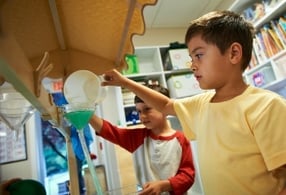
As parents, we are quick to see the problems in our day-to-day life and even quicker to articulate a solution or how something should be done. And yet, when we point out the problem and the solution all in one breath, we are getting in the way of our children developing the skill of identifying problems. To find solutions, one first has to recognize there is a problem. We want our children to be problem identifiers and problem solvers.
So how do you re-orient your child to be a problem identifier?
- Start with a simple question: How might we…? Try asking, “How might we get to school faster? How might you get dressed by yourself in the morning?” By asking the question, you are bringing their attention to something that needs to be fixed.
- Identify problems: Say, “I’m not sure what to do about this.” Not having all the solutions come from you gives children space to begin to see themselves as part of the solution.
- Let ideas and actions bubble up: Saying “Have a go at it” gives them the message that you are confident they can figure out what to do. Many times, there is more than one solution. Arriving at an initial solution and then discovering it does not solve the problem or answer the question of “How might we…?” lets children develop the skill of reiteration and empowers them by building courage to try again.
Start with the small problems - feeding the cat, getting dressed, or taking the backpack to school. Get in the habit of seeing problems as opportunities for critical thinking and collaboration as opposed to groan-and-moan issues.
In the corporate world, identifying problems and finding solutions is called Design Thinking. Schools and homes can practice the same approach. When we intervene and offer what seems to us to be the best answer, we send our children the message that they can’t take care of themselves. Our “help” deprives them of the opportunity to develop independence and resilience. Instead, include them in process along the way. In doing so, you will give them the courage and the confidence to design their own solutions. Have a go at it!



